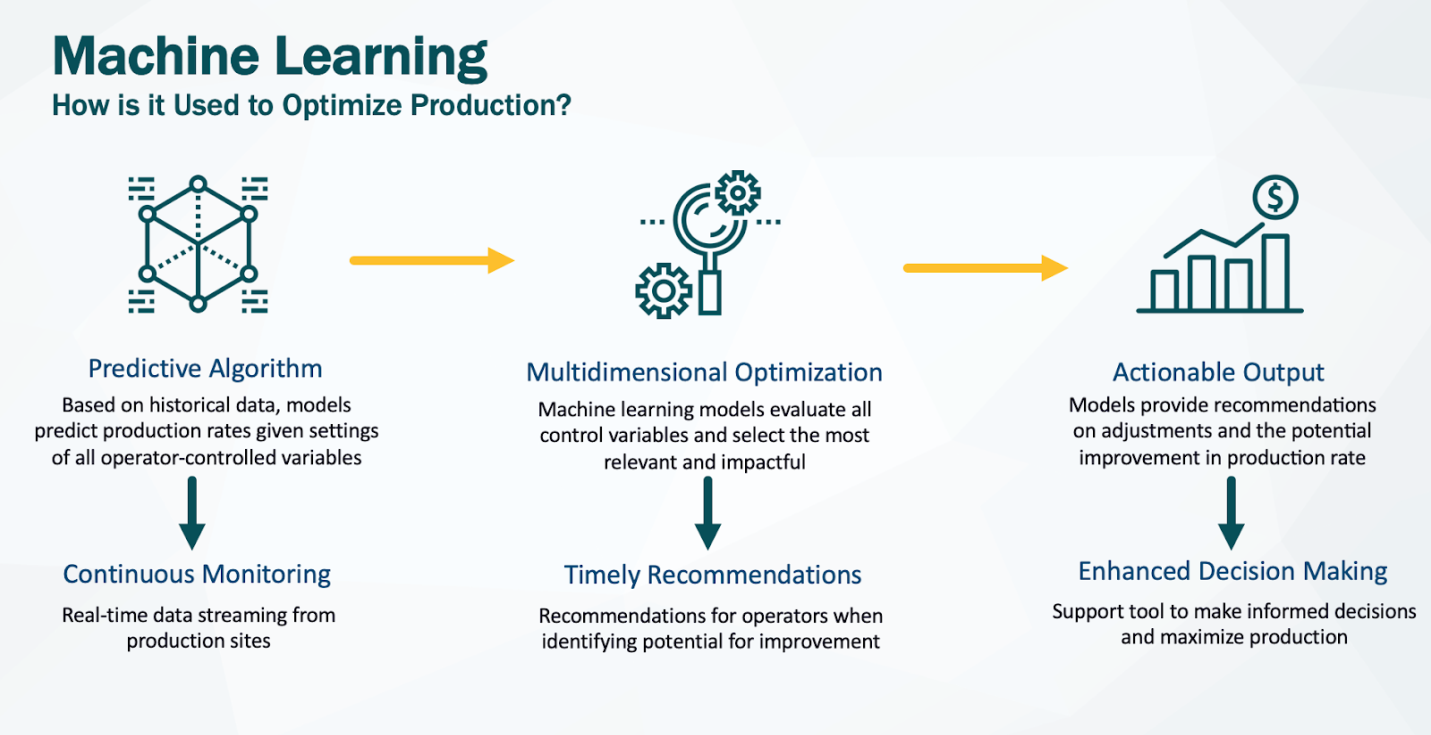The oil and gas industry as a whole is underperforming. According to research by McKinsey & Co., the average offshore platform is only realizing 77% of its full production potential. Multiply that across the industry, and that’s 10 MMbbl of oil lost every day to operational inefficiencies and $200 billion in potential annual revenue down the drain.
What accounts for this across-the-board loss in production potential? The answer lies in the inherent complexity of oil and gas operations. Every step in production relies on just the right intersection between hundreds or even thousands of variables. Data are constantly being streamed from tens of thousands of sensors, and drilling crews are in control of hundreds of variables whose potential combinations of settings range in the millions. Amid so much statistical noise, sleuthing out the actual source of inefficiencies—and finding a solution for them—becomes an impossibly tall order.
How do you decide which variables to adjust to maximize production, and what kind of adjustment is needed? Experienced subject matter experts can use their accumulated knowledge to come up with probable best courses of action based on current sensor outputs, but without support from proper analytics tools, these judgments are more art than science. And as the numbers above prove, the inherent inefficiencies in this method are taking their toll on production output.
The right tools for the job
Humans alone may not always be able to make sense of the massive amounts of variables involved in oil and gas production—but machines can. In fact, problems involving huge amounts of data and complex variable interactions are precisely where artificial intelligence (AI) and machine learning excel. Many oil and gas operators are still uncertain of AI, but these technologies are a perfect fit for the industry. And returning to McKinsey & Co.’s research, advanced analytics could yield a 30 to 50 times return on investment within just a few months of implementation, because analytics is a perfect solution to oil and gas operators’ thorny multivariable problem.
Machine learning-powered solutions can be applied to improve production efficiency in a number of ways.

Machine learning models can ingest historical data and use those to predict production rates for any given variable settings, while continuously monitoring real-time data streaming from production sites.
This is valuable, but machine learning solutions also can build further on this capability by evaluating all control variables and identifying the most relevant and impactful parameters that drive performance. Using this information, they can then provide recommendations to operators on what variables to tweak to improve output.
Finally, machine learning models can recommend specific kinds of adjustments and forecast the potential improvement in production rate. In this way, these models become an advanced tool capable of supporting enhanced, informed decision-making that in turn, enables maximized production.
Case study 1: Optimizing offshore production
As a provider of AI solutions with expertise in the oil and gas sector, SparkCognition is no stranger to applying machine learning to solve the multivariable problem and optimize production.
In one case study, a supermajor oil company partnered with SparkCognition to obtain predictive AI capable of detecting abnormalities in its gas system for offshore rigs. Specifically, the goal was to provide a single, scalable solution that could monitor all assets, despite the different behaviors and life cycles of machines within the gas system.
An unsupervised approach was used to identify normal versus anomalous behavior, and to track anomalies to downtime events. Data from the oil company were sampled into equal intervals, and the number of variables was reduced to a subset of variables that encompassed much of the variation in the dataset. The data were then clustered into different operational modes, with any datapoints that could not be clustered labeled as an anomaly. From this, a model was built that could correctly predict the cluster of any given datapoint in real time, which was retrained each month.
The model built was able to successfully identify anomalies and track them to production downtime events, giving advance warning to engineers of what, specifically, they needed to investigate and when. Asset tags were associated with the subsystem that an engineer on the rig would use to investigate a flagged anomaly. This gave engineers leading indications for root cause analysis based on the specific tags involved.
This particular solution was designed to tackle the specific multivariable problem that is the oil and gas system. Within the various subsystems of the gas and oil system, each machine serves a different purpose, has a different life cycle and exhibits different failure modes, but all are connected in a contiguous, interdependent process. This can make predictive analytics difficult to implement, despite its value to operators looking to maximize production uptime and avert unexpected failures. But the use case described here demonstrates that AI can be successfully employed to overcome this challenge.
This proof of concept was so successful that the oil company has decided to go forward with a full deployment of the same technology. The goal of this deployment—aside from providing advance warning of and insight into machine failures and downtime events—would be to allow end users in both remote and onsite centers to see notifications and warnings from the predictive maintenance solution. With this information, operators can better understand the causes of failure, optimize repair or replacement schedules and minimize production downtime.
Case study 2: Identifying downhole drill states
In another case study, SparkCognition partnered with a major oil and gas operator that was trying to improve operational efficiency by better understanding the current operating state of subterranean drillheads, using previously existing sensor and operating data.
The data used for this project included time-series edit distance on real sequences snapshots of sensor data from the downhole drilling process. Data scientists then analyzed these data for shifts in the behavior of the drillhead. Using a machine learning classification approach, 17 drill operational states were found and labeled from the data provided. A deep learning model was created that could perfectly differentiate between the different drill operating modes.
With this model, the operator was able to improve production greatly. The model provides updates on drill and rig performance in real time, allowing operators to set and update key performance indicators as needed and adjust parameters to maximize operational efficiency.
The complex tangle of variables involved in oil and gas production has long made optimization a daunting task. But new advances in machine learning and AI analytics are already being successfully implemented and netting operators massive gains in efficiency. If more operators start investing in AI solutions, then for the first time in history, the industry may be on the road to realizing the full production potential of their rigs.
Recommended Reading
Cheniere Energy Declares Quarterly Cash Dividend, Distribution
2024-01-26 - Cheniere’s quarterly cash dividend is payable on Feb. 23 to shareholders of record by Feb. 6.
Marathon Petroleum Sets 2024 Capex at $1.25 Billion
2024-01-30 - Marathon Petroleum Corp. eyes standalone capex at $1.25 billion in 2024, down 10% compared to $1.4 billion in 2023 as it focuses on cost reduction and margin enhancement projects.
Humble Midstream II, Quantum Capital Form Partnership for Infrastructure Projects
2024-01-30 - Humble Midstream II Partners and Quantum Capital Group’s partnership will promote a focus on energy transition infrastructure.
BP’s Kate Thomson Promoted to CFO, Joins Board
2024-02-05 - Before becoming BP’s interim CFO in September 2023, Kate Thomson served as senior vice president of finance for production and operations.
Magnolia Oil & Gas Hikes Quarterly Cash Dividend by 13%
2024-02-05 - Magnolia’s dividend will rise 13% to $0.13 per share, the company said.





